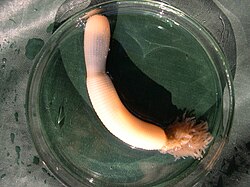| Cycloneuralia Temporal range: | |
|---|---|
 | |
| Priapulus caudatus | |
| Scientific classification | |
| Domain: | Eukaryota |
| Kingdom: | Animalia |
| Subkingdom: | Eumetazoa |
| Clade: | ParaHoxozoa |
| Clade: | Bilateria |
| Clade: | Nephrozoa |
| Clade: | Protostomia |
| Superphylum: | Ecdysozoa |
| Clade: | Cycloneuralia |
| Subclades | |
Cycloneuralia is a proposed clade of ecdysozoan animals including the Scalidophora (Kinorhynchans, Loriciferans, Priapulids), the Nematoida (nematodes, Nematomorphs), and the extinct Palaeoscolecida. [1] [2] It may be paraphyletic, or may be a sister group to Panarthropoda. Or perhaps Panarthropoda is paraphyletic with respect to Cycloneuralia. [3] The group has also been considered a single phylum, sometimes given the old name Nemathelminthes. [4] The uniting character is the nervous system organization with a circumpharyngeal brain and somata–neuropil–somata pattern. [5] The name derives from the position of the brain around the pharynx. [6]